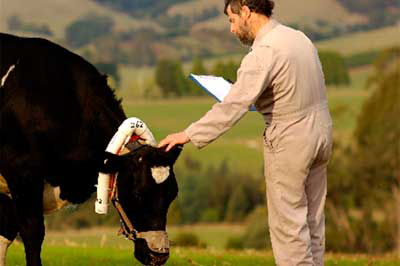Reducing more methane from dairy cows

A grazing dairy cow can burp up to 600 grams of methane per day. As a greenhouse gas, methane is about 25 times more powerful than carbon dioxide and methane emissions from cows constitute about 65% of the total dairy farm greenhouse gas emissions. Australian dairy farmers are to be congratulated for achieving 28% reduction in methane emissions per litre of milk in 2010 compared to 1980. However, a further reduction of methane emissions is required.
Carbon Farming Initiative
The Australian government’s Department of Climate Change and Energy Efficiency and Dairy Australia are setting the Carbon Farming Initiative to provide incentives for dairy farmers to reduce emissions from their milking cows. Emissions will be reduced by changing the cows’ diet. Research team from the Victorian Department of Primary Industries and the University of Melbourne explored dietary interventions, demonstrating that feeds containing tannins or high levels of oil reduce methane production from livestock. The research focused on providing dairy farmers with an option for reducing greenhouse gas emissions from milking cows through feeding dietary additives.
The proposed methodology alters the activity of the gut’s methane-producing microorganisms, reducing the amount of methane belched by cattle from their digestive system.
The organisms in the fore-stomach of sheep and cattle produce methane – called enteric methane – from the hydrogen and carbon dioxide that result from microbial digestion of cows’ food.
Strategies for reducing enteric methane include breeding for lower methane-producing animals, microbial interventions, and nutrition and animal management. Most of these are being researched at the Department of Agriculture, Fisheries and Forestry, through the National Livestock Methane Program. Over the next few years a number of these strategies will be developed into new Carbon Farming Initiative methods to reduce enteric methane.
Methane reduction can be realised by:
• Reducing fibre digestion
• Lowering total feed intake (although undesirable, and only occurs when total dietary fat exceeds 6% to 7% of total intake)
• Suppressing the micro-organisms that make methane and suppressing rumen protozoa, on which those organisms depend.
• Tannins, by directly suppressing methane-making micro-organisms.
• Different dietary oils, by-products from other agricultural processes.
The by-products studied included whole cotton seed, cold-pressed canola meal, hominy meal and brewers grains. They can theoretically be sourced as by-products of biofuel production. At the same time, the additional energy supplied with these by-products can increase milk production. It could be interesting for commercial application, but the profitability depends on the comparative price of conventional grain feeding.
Tannin and oils as feed additives
The research team then asked – if tannin and oils were added to the diet, would this have an additive effect on inhibiting methane production? However, when added to the diet as pure extracts, tannins and oils appeared to neutralise each other (perhaps with the tannin binding the oils making the combination ineffective). The focus shifted to potential feed additives that contain both tannin and oil, naturally occurring in one product. The obvious choice was grape marc, a by-product of wine making with a high concentration of both fat and tannins. Feeding grape marc to dairy cattle reduced methane by up to 20%.
There are limited data in the literature concerning in vivo effects of dietary fat supplementation on enteric methane emissions from lactating dairy cows. As the methodology can only be built on peer reviewed research, the team combined own findings with other literatures to demonstrate that for every 1% extra oil added to the diet of livestock, enteric methane can be reduced by 3.5%. The upper limit for dietary fats and oils in feed is 7% and the natural oils in grass range from 1% in summer to 5% in spring, so there is a window of 90 days in the summer when natural grass oils are low enough that supplementary feeding can be introduced to reduce enteric methane production.
This evidence was considered to underpin the first CFI offset methodology for livestock. Accordingly the method was released for public consultation until last week. When it’s approved – together with those already approved for destruction of methane from dairy manure ponds and removal of carbon dioxide through environmental plantings – it will give dairy farmers options to take part in the Carbon Farming Initiative. As the income from the initiative is relatively modest, these methods will be possibly adopted where they bring productivity gains or align with broader farming objectives.











